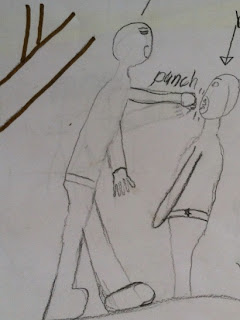Learning about Carpets for Communities (CfC) helping to break the cycle of poverty in Cambodia, lead on to
the students wanting a carpet for our classroom. I think in the past I might
have taken that idea on board and ordered one for the class, but this time I
saw a lot of good learning in this simple desire for a rug and so we did it
together.
Rug size
We had to choose the carpet size
first of all so we found the carpet measurements from the CfC website and
marked out the sizes on our classroom floor. One of my most disengaged students
was in charge of the tape measure. I loved that there was relevance and purpose
in this simple (but not simple for all) numeracy task and it ‘hooked’ him in to
learning. After marking out the sizes we had a ‘hands up’ vote for which size
to order and there was a unanimous vote for the largest rug. We looked at the
cost and did a quick calculation to see if we had enough money in our class
budget.
Rug design
I set the kids the task to design
the rug for our class. Once again I was so happy with their enthusiasm of the
task. We had ended up with 12 different designs so we needed to take a vote.
The vote
I started with a ‘hands up’ vote
– something you would think is a simple task. Wrong! I had kids calling out to
other kids trying to persuade them to vote a certain way. There was absolutely
no subtlety to the way they were bullying each other into their decisions.
Voting attempt #2
So
we tried a silent vote instead where students voted for their favorite design on
an anonymous piece of paper, free from the ridicule and bullying of their
peers. We had 12 students there and instead of ending up with 12 votes, we
ended up with 16! I explained that this was called cheating and that it was
important that we could make a decision as a class without bullying or cheating
so we would have to try again.
Voting attempt # 3
It was extremely hard not to get
frustrated by this and just drop the task but I took it as a good opportunity to
learn how to have a simple vote in a civilized way, something that I believe would
come in handy in the community. I gave out jobs to different students such as
handing out the ballot paper, collecting the votes, counting the votes and recording
the results. Finally we had a successful vote!
A democratic classroom
There was unfortunately still jeering
for the person whose design won and shaming the person whose designs didn’t
win. I explained that this vote is not about wining or losing, that it is about
making a decision as a group. I compared it to our democratic society in
Australia and that we could be living in a country where our leader makes all
the decisions for us, but instead we live in a country where people get to have
their say by voting. I compared this to our classroom and explained that we
could have a classroom where I make the decisions for everyone and I would
decide which rug we would get, but instead I want you all to have a say and
make a decision together. I hoped that they found this idea empowering.
Regardless of the jeers and cheers, I congratulated them on making a decision
as a class.
A valuable learning experience
This voting process (and all the
attempts) probably took nearly 1 hour. I think in the past I wouldn’t have used
the time in this way as I would have been riddled with guilt that I’m steering
off the path of core business (literacy and numeracy). Although I know that
literacy and numeracy is extremely important for our students, I honestly
believe this other learning should not be overlooked. Problems in the classroom
often involve arguments, swearing, fights and tears – and I think it’s not too
different out in community. And so I believe that these experiences and skills in
making a civilized vote as a class is something that could be very useful to my
students and their community.
Here is the final design J
Meanwhile... on the Cambodian side of things...
After this lesson I emailed Carpets for Communities to explain what I have been doing with my class and to order the rug. Just the other day I stumbled across this picture posted on their Facebook page and thought "Hey! That looks familiar!".
It's nearly done!























